 The Two Micron All Sky Survey at IPAC
The Two Micron All Sky Survey at IPAC
|
|
|
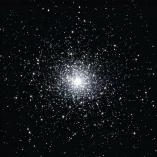 The globular cluster 47 Tucanae, one of the brightest
Milky Way globular star clusters.
This cluster, seen near the Small Magellanic Cloud in the sky,
and at a distance of 4.6 kpc (15000 light years) from us and 7.3 kpc (23800
light years) from the Galactic Center, likely contains about 1 million stars.
Its optical half-light radius is 2.79´, or only 3.7 pc; the stars in
globular clusters, such as 47 Tuc, are clearly densely packed. This cluster
is known to be typically metal-rich, relative to many other globular clusters.
Globular clusters formed early in the Galaxy's history and, therefore, must
have been chemically enriched by massive short-lived stars. The luminosity
functions for globular clusters vary, with metal-rich clusters having flatter
function slopes than metal-poor clusters; recent indications are that a
cluster's interaction with the Galactic disk could strip lower-mass stars from
the cluster, leading to a relative
overabundance of higher-mass stars, which would lead to greater enrichment of
elements, such as oxygen. In the near-IR, globular cluster stars look very
homogeneous, as can be seen in this image, with very little in the way of
color or population gradients, particularly in the central regions (see also
Montegriffo et al. 1995, MNRAS, 276, 739). The near-IR light is dominated by
the old red giants and asymptotic giant branch stars in the cluster.
Image mosaic by E. Kopan (IPAC). (Field size 19.2´ × 23.3´.
Image size 771 kB.)
The globular cluster 47 Tucanae, one of the brightest
Milky Way globular star clusters.
This cluster, seen near the Small Magellanic Cloud in the sky,
and at a distance of 4.6 kpc (15000 light years) from us and 7.3 kpc (23800
light years) from the Galactic Center, likely contains about 1 million stars.
Its optical half-light radius is 2.79´, or only 3.7 pc; the stars in
globular clusters, such as 47 Tuc, are clearly densely packed. This cluster
is known to be typically metal-rich, relative to many other globular clusters.
Globular clusters formed early in the Galaxy's history and, therefore, must
have been chemically enriched by massive short-lived stars. The luminosity
functions for globular clusters vary, with metal-rich clusters having flatter
function slopes than metal-poor clusters; recent indications are that a
cluster's interaction with the Galactic disk could strip lower-mass stars from
the cluster, leading to a relative
overabundance of higher-mass stars, which would lead to greater enrichment of
elements, such as oxygen. In the near-IR, globular cluster stars look very
homogeneous, as can be seen in this image, with very little in the way of
color or population gradients, particularly in the central regions (see also
Montegriffo et al. 1995, MNRAS, 276, 739). The near-IR light is dominated by
the old red giants and asymptotic giant branch stars in the cluster.
Image mosaic by E. Kopan (IPAC). (Field size 19.2´ × 23.3´.
Image size 771 kB.)

The globular cluster Omega Centauri.Mosaic image construction by E. Kopan (IPAC).
(Field size 0.56° × 0.78°. Image size 338 kB.)
 The globular cluster Messier 2. Note the uniformity in
color for these old, red stars in the cluster.
The globular cluster Messier 2. Note the uniformity in
color for these old, red stars in the cluster.
(Field size 10.0´ × 10.0´. Image size 342 kB.)

The globular cluster, Messier 3 (NGC 5272).
(Field size 9.0´ × 8.2´. Image size 93 kB.)

The globular cluster Messier 4. (Field size 6.4´ × 6.4´.
Image size 184 kB.)

The globular cluster Messier 5.
(Field size 12.0´ × 12.0´. Image size 417 kB.)
 The globular cluster Messier 9. (Field size 8.2´ × 8.3´.
Image size 240 kB.)
The globular cluster Messier 9. (Field size 8.2´ × 8.3´.
Image size 240 kB.)
 The globular cluster Messier 10. (Field size 11.7´ × 11.7´.
Image size 509 kB.)
The globular cluster Messier 10. (Field size 11.7´ × 11.7´.
Image size 509 kB.)
 The globular cluster Messier 11. (Field size 10´ × 10´.
Image size 384 kB.)
The globular cluster Messier 11. (Field size 10´ × 10´.
Image size 384 kB.)
 The globular cluster Messier 12. (Field size 11.0´ × 11.0´.
Image size 369 kB.)
The globular cluster Messier 12. (Field size 11.0´ × 11.0´.
Image size 369 kB.)
 The globular star cluster Messier 13.
(Field size 13.0´ × 13.0´. Image size 530 kB.)
The globular star cluster Messier 13.
(Field size 13.0´ × 13.0´. Image size 530 kB.)
 The globular cluster Messier 14. (Field size 6.2´ × 6.2´.
Image size 165 kB.)
The globular cluster Messier 14. (Field size 6.2´ × 6.2´.
Image size 165 kB.)

The globular cluster Messier 15.
(Field size 8.3´ × 7.5´. Image size 180 kB.)
 The globular cluster Messier 19. (Field size 12.0´ × 12.0´.
Image size 165 kB.)
The globular cluster Messier 19. (Field size 12.0´ × 12.0´.
Image size 165 kB.)
 The globular cluster Messier 22. (Field size 11.0´ × 11.0´.
Image size 330 kB.)
The globular cluster Messier 22. (Field size 11.0´ × 11.0´.
Image size 330 kB.)
 The globular cluster Messier 28. (Field size 6.7´ × 6.7´.
Image size 164 kB.)
The globular cluster Messier 28. (Field size 6.7´ × 6.7´.
Image size 164 kB.)
 The globular cluster Messier 30. (Field size 10.8´ × 10.8´.
Image size 400 kB.)
The globular cluster Messier 30. (Field size 10.8´ × 10.8´.
Image size 400 kB.)

The globular cluster, Messier 53. Again, note the general uniformity
in color for the stars in the cluster. (A persistence pattern from a bright
star can be extending down the lower left side of the image. These patterns
are easily and properly identified and flagged in the 2MASS source catalog.)
(Field size 11.5´ × 8.4´. Image size 226 kB.)
 The globular cluster Messier 54. (Field size 11.4´ × 9.6´.
Image size 473 kB.)
The globular cluster Messier 54. (Field size 11.4´ × 9.6´.
Image size 473 kB.)
 The globular cluster Messier 55. (Field size 11.7´ × 11.7´.
Image size 502 kB.)
The globular cluster Messier 55. (Field size 11.7´ × 11.7´.
Image size 502 kB.)
 The globular cluster Messier 56. (Field size 8´ × 8´.
Image size 243 kB.)
The globular cluster Messier 56. (Field size 8´ × 8´.
Image size 243 kB.)
 The globular cluster Messier 62. (Field size 7.0´ × 7.0´.
Image size 174 kB.)
The globular cluster Messier 62. (Field size 7.0´ × 7.0´.
Image size 174 kB.)
 The globular cluster Messier 68.
Salaris & Weiss (2002, A&A, 388, 492) recently
determined the age of the cluster to be 11.2 Gyr, which is slightly older
than the ~10 Gyr found by Brocato, Castellani, & Piersimoni (1997, ApJ,
491, 789). This cluster is relatively metal-poor. The light from globular
clusters in the near-infrared is dominated by old red giant stars, which
have approximately the same near-infrared colors. Thus, all the stars appear
to be about the same color, although not necessarily the same brightness.
(Field size 10´ × 10´.
Image size 366 kB.)
The globular cluster Messier 68.
Salaris & Weiss (2002, A&A, 388, 492) recently
determined the age of the cluster to be 11.2 Gyr, which is slightly older
than the ~10 Gyr found by Brocato, Castellani, & Piersimoni (1997, ApJ,
491, 789). This cluster is relatively metal-poor. The light from globular
clusters in the near-infrared is dominated by old red giant stars, which
have approximately the same near-infrared colors. Thus, all the stars appear
to be about the same color, although not necessarily the same brightness.
(Field size 10´ × 10´.
Image size 366 kB.)
 The globular cluster Messier 69. (Field size 8.2´ × 12.0´.
Image size 406 kB.)
The globular cluster Messier 69. (Field size 8.2´ × 12.0´.
Image size 406 kB.)
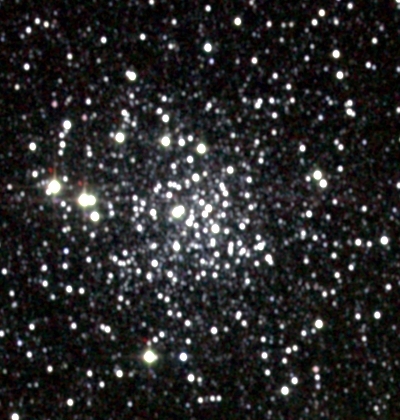 The globular cluster Messier 71. (Field size 6.7´ × 7.0´.
Image size 187 kB.)
The globular cluster Messier 71. (Field size 6.7´ × 7.0´.
Image size 187 kB.)
 The globular cluster Messier 72. (Field size 7.7´ × 9.5´.
Image size 285 kB.)
The globular cluster Messier 72. (Field size 7.7´ × 9.5´.
Image size 285 kB.)
 The globular cluster Messier 75. (Field size 6.0´ × 6.0´.
Image size 135 kB.)
The globular cluster Messier 75. (Field size 6.0´ × 6.0´.
Image size 135 kB.)
 The globular cluster Messier 79. (Field size 5.5´ × 5.5´.
Image size 138 kB.)
The globular cluster Messier 79. (Field size 5.5´ × 5.5´.
Image size 138 kB.)
 The globular cluster Messier 80. (Field size 6.7´ × 6.7´.
Image size 197 kB.)
The globular cluster Messier 80. (Field size 6.7´ × 6.7´.
Image size 197 kB.)

The globular cluster Messier 92. This image was made from 10 individual
cross-scan test images, which were coadded together, and therefore represents a total
exposure time of nearly 80 seconds. The signal-to-noise in the image, then, is improved
by about a factor of 3 over a single scan image.
(Field size 6.9´ × 6.9´. Image size 144 kB.)
 The globular cluster Messier 107. (Field size 13.1´ × 12.5´.
Image size 582 kB.)
The globular cluster Messier 107. (Field size 13.1´ × 12.5´.
Image size 582 kB.)
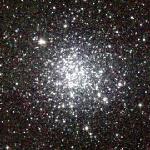 Atlas Image mosaic of NGC 3201,
a low galactic latitude globular star cluster. Although the 2MASS imaging and
pipeline photometry is not optimized for such crowded regions as globular
clusters, because NGC 3201 has a relatively lower concentration of stars, the
near-infrared photometry resulting from the pipeline processing reasonably
represents the stellar populations in the cluster, as seen in the resulting
color-color and
color-magnitude diagrams. In the latter diagram we clearly see the
red giant, asymptotic giant, and horizontal branches for the cluster.
Following the recent analysis by von Braun & Mateo (2001, AJ, 121, 1522) we
show on the color-magnitude diagram an overlay of a low-metallicity isochrone,
reddened by E(V-I)=0.24 at a distance of ~4.5 kpc (14670 light years), with an
age of ~14 Gyr (billion years). Image mosaic by S. Van Dyk (IPAC).
(Field size 6´ × 6´. Image size 553 kB.)
Atlas Image mosaic of NGC 3201,
a low galactic latitude globular star cluster. Although the 2MASS imaging and
pipeline photometry is not optimized for such crowded regions as globular
clusters, because NGC 3201 has a relatively lower concentration of stars, the
near-infrared photometry resulting from the pipeline processing reasonably
represents the stellar populations in the cluster, as seen in the resulting
color-color and
color-magnitude diagrams. In the latter diagram we clearly see the
red giant, asymptotic giant, and horizontal branches for the cluster.
Following the recent analysis by von Braun & Mateo (2001, AJ, 121, 1522) we
show on the color-magnitude diagram an overlay of a low-metallicity isochrone,
reddened by E(V-I)=0.24 at a distance of ~4.5 kpc (14670 light years), with an
age of ~14 Gyr (billion years). Image mosaic by S. Van Dyk (IPAC).
(Field size 6´ × 6´. Image size 553 kB.)
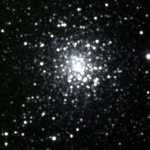
The globular cluster NGC 6356.
(Field size 5.0´ × 5.0´. Image size 105 kB.)
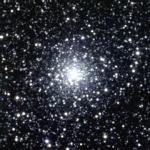 Atlas Image mosaic of NGC 6440, a
globular star cluster is near the Galactic center, at a distance of 8.5
kpc (27710 light years) and reddened by about three visual magnitudes
(Ortolani et al. 1994, A&AS 108, 653). NGC 6440 is also interesting because
it has long shown to contain bright X-ray sources; a bright transient source
was detected by the BeppoSAX satellite in 1998 August. This source
has been studied by Verbunt et al. (2000, A&A, 359, 960). The X-ray point
sources are similar in property to
low-mass X-ray binaries seen in the Galactic plane. These interacting binary
systems likely contain ultracompact primary stars, possibly black holes
(Sidoli et al. 2001, A&A, 368, 451). Image mosaic by S. Van Dyk (IPAC).
(Field size 7´ × 7´. Image size 190 kB.)
Atlas Image mosaic of NGC 6440, a
globular star cluster is near the Galactic center, at a distance of 8.5
kpc (27710 light years) and reddened by about three visual magnitudes
(Ortolani et al. 1994, A&AS 108, 653). NGC 6440 is also interesting because
it has long shown to contain bright X-ray sources; a bright transient source
was detected by the BeppoSAX satellite in 1998 August. This source
has been studied by Verbunt et al. (2000, A&A, 359, 960). The X-ray point
sources are similar in property to
low-mass X-ray binaries seen in the Galactic plane. These interacting binary
systems likely contain ultracompact primary stars, possibly black holes
(Sidoli et al. 2001, A&A, 368, 451). Image mosaic by S. Van Dyk (IPAC).
(Field size 7´ × 7´. Image size 190 kB.)
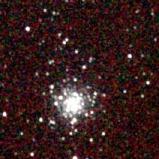
The globular cluster NGC 7006, which is seen near the edge of a 2MASS
scan, lies at a galactocentric radius of 40 kpc. At this distance, it becomes an important probe of
the timescale and mechanism for the collapse of the Galaxy and crucial for
the interpretation of the Galaxy's subsequent chemical evolution (Buonanno et
al. 1991, AJ, 102, 1005).
(Field size 5.5´ × 6.7´. Image size 105 kB.)
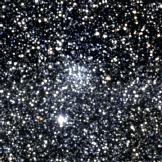 Atlas Image mosaic of the globular cluster Palomar
6, which is in the direction of the Galactic bulge. The loose cluster is
optically obscured, but more prominent among the surrounding bulge stars in the
near-infrared. Ortolani et al. (1995, A&A, 296, 680) determined that the
cluster is seen through about four visual magnitudes of extinction, at a
distance from us of about 8.9 kiloparsecs (29000 light years), placing it
nearby the Galactic center. They determined that
the cluster is relatively metal-rich, higher in metals than
47 Tucanae.
Although the spatial resolution of 2MASS is insufficient to overcome the
extreme stellar crowding within the cluster, 2MASS is well suited for revealing
obscured clusters in the Galaxy and for
studying the cluster environment. Image mosaic by S. Van Dyk (IPAC).
These data are included in the Second Incremental Release!
(Field size 7.5´ × 7.5´. Image size 240 kb.)
Atlas Image mosaic of the globular cluster Palomar
6, which is in the direction of the Galactic bulge. The loose cluster is
optically obscured, but more prominent among the surrounding bulge stars in the
near-infrared. Ortolani et al. (1995, A&A, 296, 680) determined that the
cluster is seen through about four visual magnitudes of extinction, at a
distance from us of about 8.9 kiloparsecs (29000 light years), placing it
nearby the Galactic center. They determined that
the cluster is relatively metal-rich, higher in metals than
47 Tucanae.
Although the spatial resolution of 2MASS is insufficient to overcome the
extreme stellar crowding within the cluster, 2MASS is well suited for revealing
obscured clusters in the Galaxy and for
studying the cluster environment. Image mosaic by S. Van Dyk (IPAC).
These data are included in the Second Incremental Release!
(Field size 7.5´ × 7.5´. Image size 240 kb.)
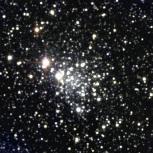 Atlas Image mosaic of Tonantzintla 2 (Pismis 26),
which is one of the least-known Galactic globular clusters. At
l=350.8° and b=-3.4°, it is quite close to the
Galactic Center. From V and I photometry using the ESO 3.6-m NTT, Bica,
Ortolani, & Barbuy (1996, A&AS, 120, 153) found that the positions of
red giant branch and horizontal branch stars on the optical color-magnitude
diagram indicate that the chemical composition of the cluster stars are
similar to those in
47 Tucanae. They also found a reddening to the cluster which implies an
extinction of AV~4 magnitudes, and a distance
from us of 6.4 kpc (20,900 light years). Bica et al. conclude that Ton 2
belongs to the bulge population of the Milky Way, but is only moderately
"metal-rich". Image mosaic by S. Van Dyk.
Look also at preliminary 2MASS near-infrared
color-color
and color-magnitude diagrams. (These include
all stars in the Atlas Image Mosaic detected by the 2MASS pipeline processing;
crowding affects and limits the detections and photometry of stars in the
densest regions of the cluster.)
(Field size 7.0´ × 7.0´. Image size 184 kb.)
Atlas Image mosaic of Tonantzintla 2 (Pismis 26),
which is one of the least-known Galactic globular clusters. At
l=350.8° and b=-3.4°, it is quite close to the
Galactic Center. From V and I photometry using the ESO 3.6-m NTT, Bica,
Ortolani, & Barbuy (1996, A&AS, 120, 153) found that the positions of
red giant branch and horizontal branch stars on the optical color-magnitude
diagram indicate that the chemical composition of the cluster stars are
similar to those in
47 Tucanae. They also found a reddening to the cluster which implies an
extinction of AV~4 magnitudes, and a distance
from us of 6.4 kpc (20,900 light years). Bica et al. conclude that Ton 2
belongs to the bulge population of the Milky Way, but is only moderately
"metal-rich". Image mosaic by S. Van Dyk.
Look also at preliminary 2MASS near-infrared
color-color
and color-magnitude diagrams. (These include
all stars in the Atlas Image Mosaic detected by the 2MASS pipeline processing;
crowding affects and limits the detections and photometry of stars in the
densest regions of the cluster.)
(Field size 7.0´ × 7.0´. Image size 184 kb.)
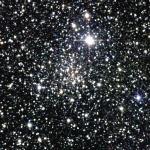 Atlas Image mosaic of the star cluster Lyngå 7.
The true nature of this low-galactic-latitude cluster is unclear.
The cluster was listed as an open cluster by Lyngå (1987, Lund Catalog
of Open Cluster Data, 5th ed.), but Ortolani et al. (1993, A&A, 273, 415),
based on a BVI optical color-magnitude diagram, conclude that Lyngå 7
would have to be among the oldest known open clusters. They conclude that
it is likely a very young metal-rich globular cluster. Tavarez & Friel (1995,
AJ, 110, 223), based on an integrated optical spectrum of the cluster, find
that its location (galactocentric distance R0=4.4 kpc;
7.2 kpc from us),
kinematics (6±15 km/s), and metallicity ([Fe/H]=-0.62±0.15 dex)
make it consistent with the disk globular cluster population, with an
age
Atlas Image mosaic of the star cluster Lyngå 7.
The true nature of this low-galactic-latitude cluster is unclear.
The cluster was listed as an open cluster by Lyngå (1987, Lund Catalog
of Open Cluster Data, 5th ed.), but Ortolani et al. (1993, A&A, 273, 415),
based on a BVI optical color-magnitude diagram, conclude that Lyngå 7
would have to be among the oldest known open clusters. They conclude that
it is likely a very young metal-rich globular cluster. Tavarez & Friel (1995,
AJ, 110, 223), based on an integrated optical spectrum of the cluster, find
that its location (galactocentric distance R0=4.4 kpc;
7.2 kpc from us),
kinematics (6±15 km/s), and metallicity ([Fe/H]=-0.62±0.15 dex)
make it consistent with the disk globular cluster population, with an
age 12 billion years. Tavarez & Friel find a reddening to
the cluster of E(B-V)=0.73; here we show
the 2MASS color-color diagram for the cluster. It is difficult to exactly
determine the reddening from this diagram, but it does appear to be modest.
Here we show the 2MASS color-magnitude diagram,
with Padua theoretical isochrones (Bertelli et al. 1994, A&AS, 106, 275)
overlaid. An age of ~12 billion years (green line) is consistent with
the near-infrared data, however, with a lower reddening, E(B-V)~0.60.
(The diagram also shows that ages of 10 billion years [red line]
and 14.5 billion years [blue line] are also consistent with the data,
since these age tracks become somewhat degenerate in the near-infrared colors;
scatter in the datapoints, due to crowding, is also present;
the other bluer stars on the diagram are foreground stellar contamination.)
At least one likely dust-enshrouded AGB star, the reddish star
(Ks=8.03, J-Ks=4.55, not shown on the diagram) is
evident in the cluster (the other reddish
"star" just south of the brightest star in the image is a known artifact).
Lyngå 7 represents an important
link between the oldest open clusters and the youngest globular clusters in
the Galaxy. These data are included in the Second Incremental Release!
(Field size 10.0´ × 10.0´. Image size 184 kb.)
12 billion years. Tavarez & Friel find a reddening to
the cluster of E(B-V)=0.73; here we show
the 2MASS color-color diagram for the cluster. It is difficult to exactly
determine the reddening from this diagram, but it does appear to be modest.
Here we show the 2MASS color-magnitude diagram,
with Padua theoretical isochrones (Bertelli et al. 1994, A&AS, 106, 275)
overlaid. An age of ~12 billion years (green line) is consistent with
the near-infrared data, however, with a lower reddening, E(B-V)~0.60.
(The diagram also shows that ages of 10 billion years [red line]
and 14.5 billion years [blue line] are also consistent with the data,
since these age tracks become somewhat degenerate in the near-infrared colors;
scatter in the datapoints, due to crowding, is also present;
the other bluer stars on the diagram are foreground stellar contamination.)
At least one likely dust-enshrouded AGB star, the reddish star
(Ks=8.03, J-Ks=4.55, not shown on the diagram) is
evident in the cluster (the other reddish
"star" just south of the brightest star in the image is a known artifact).
Lyngå 7 represents an important
link between the oldest open clusters and the youngest globular clusters in
the Galaxy. These data are included in the Second Incremental Release!
(Field size 10.0´ × 10.0´. Image size 184 kb.)
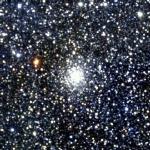 Atlas Image mosaic of the globular cluster
UKS 1 (aka UKS 1751-24.1). This cluster, in the Galactic bulge and
near the Galactic center (l=5.1°, b=0.8°), is quite
reddened and in a very crowded stellar field. Ortolani, Bica, & Barbuy (1997,
A&AS, 126, 319) present optical photometry of the cluster and find that the
extinction is nearly 11 visual magnitudes, that the distance to the cluster is
7.4 kpc (24,124 light years), and that the cluster may be metal-rich.
Near-infrared photometry was previously obtained for the stars in the cluster,
along with those for 19 other bulge clusters, by Minniti, Olszewski, & Rieke
(1995, AJ, 110, 1686). Their main conclusion is that there is no apparent
difference between the majority of the bulge stellar population and that of
the most metal-rich bulge globular clusters. Click
here for a 2MASS color-color diagram for UKS 1, and h
ere
for a color-magnitude diagram. With the caveat that the 2MASS pipeline
photometry is not accurate in crowded regions, such as globular clusters,
the photometry tends to suggest that, given the Ortolani et al. distance,
for a 14 Gyr isochrone with solar metallicity, the extinction to the cluster
is more at about 8.5 visual magnitudes. Image mosaic by S. Van Dyk (IPAC).
(Field size 8.0´ × 8.0´. Image size 262 kb.)
Atlas Image mosaic of the globular cluster
UKS 1 (aka UKS 1751-24.1). This cluster, in the Galactic bulge and
near the Galactic center (l=5.1°, b=0.8°), is quite
reddened and in a very crowded stellar field. Ortolani, Bica, & Barbuy (1997,
A&AS, 126, 319) present optical photometry of the cluster and find that the
extinction is nearly 11 visual magnitudes, that the distance to the cluster is
7.4 kpc (24,124 light years), and that the cluster may be metal-rich.
Near-infrared photometry was previously obtained for the stars in the cluster,
along with those for 19 other bulge clusters, by Minniti, Olszewski, & Rieke
(1995, AJ, 110, 1686). Their main conclusion is that there is no apparent
difference between the majority of the bulge stellar population and that of
the most metal-rich bulge globular clusters. Click
here for a 2MASS color-color diagram for UKS 1, and h
ere
for a color-magnitude diagram. With the caveat that the 2MASS pipeline
photometry is not accurate in crowded regions, such as globular clusters,
the photometry tends to suggest that, given the Ortolani et al. distance,
for a 14 Gyr isochrone with solar metallicity, the extinction to the cluster
is more at about 8.5 visual magnitudes. Image mosaic by S. Van Dyk (IPAC).
(Field size 8.0´ × 8.0´. Image size 262 kb.)
 Atlas Image mosaic of Liller 1,
which is a globular
star cluster in the plane of the Milky Way Galaxy, about 5° from the
Galactic center. The cluster, at a distance of 8700
pc (28400 light years) from us, is seen through about 9 magnitudes of visual
extinction, rendering it nearly invisible at optical wavelengths.
The cluster is relatively metal-rich, that is, the abundance of elements heavier
than helium is relatively high, possibly as high as the Sun. The recent
near-infrared analysis of Liller 1 by Davidge (2000, ApJS, 126, 105) indicate
that the cluster has characteristics in common with stars in the Galactic
bulge. The HST/NICMOS photometry by Ortolani et al. (2001, A&A, 376, 878)
shows the faint red horizontal branch stars in the cluster for the first time,
confirming the high metallicity; the main sequence turnoff is also seen in
their analysis, but not clearly enough to estimate the cluster's age.
Image mosaic by S. Van Dyk (IPAC).
(Field size 8.0´ × 8.0´. Image size 253 kb.)
Atlas Image mosaic of Liller 1,
which is a globular
star cluster in the plane of the Milky Way Galaxy, about 5° from the
Galactic center. The cluster, at a distance of 8700
pc (28400 light years) from us, is seen through about 9 magnitudes of visual
extinction, rendering it nearly invisible at optical wavelengths.
The cluster is relatively metal-rich, that is, the abundance of elements heavier
than helium is relatively high, possibly as high as the Sun. The recent
near-infrared analysis of Liller 1 by Davidge (2000, ApJS, 126, 105) indicate
that the cluster has characteristics in common with stars in the Galactic
bulge. The HST/NICMOS photometry by Ortolani et al. (2001, A&A, 376, 878)
shows the faint red horizontal branch stars in the cluster for the first time,
confirming the high metallicity; the main sequence turnoff is also seen in
their analysis, but not clearly enough to estimate the cluster's age.
Image mosaic by S. Van Dyk (IPAC).
(Field size 8.0´ × 8.0´. Image size 253 kb.)
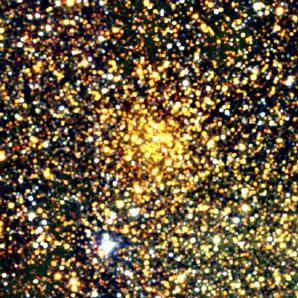 Atlas Image of a new globular cluster
candidate seen near the Galactic Plane, only 10° away from the Galactic
Center. This object was serendipitously discovered in the 2MASS data, and
is primarily seen only in the H and Ks bands; hence, the rather
reddish color for the cluster stars. The characteristics of the stars and
the total extinction to the cluster have not yet been determined, however,
further analysis, including follow-up non-2MASS observations, will be
undertaken. To date there are 147 known globular clusters associated with our
Milky Way Galaxy; if confirmed to be a globular, this new cluster would be
number 148. Because these clusters are know to exist in larger numbers towards
the center of our Galaxy it is likely that a number are hidden behind
dust clouds found in that direction, many of which may be discovered by
2MASS. For more about this discovery, see the abstract
for the poster presentation at the 194th Meeting of the American Astronomical
Society. (Field size 6.8´ × 6.8´. Image size 105 kB.)
Atlas Image of a new globular cluster
candidate seen near the Galactic Plane, only 10° away from the Galactic
Center. This object was serendipitously discovered in the 2MASS data, and
is primarily seen only in the H and Ks bands; hence, the rather
reddish color for the cluster stars. The characteristics of the stars and
the total extinction to the cluster have not yet been determined, however,
further analysis, including follow-up non-2MASS observations, will be
undertaken. To date there are 147 known globular clusters associated with our
Milky Way Galaxy; if confirmed to be a globular, this new cluster would be
number 148. Because these clusters are know to exist in larger numbers towards
the center of our Galaxy it is likely that a number are hidden behind
dust clouds found in that direction, many of which may be discovered by
2MASS. For more about this discovery, see the abstract
for the poster presentation at the 194th Meeting of the American Astronomical
Society. (Field size 6.8´ × 6.8´. Image size 105 kB.)
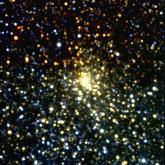 Atlas Image mosaic of a previously-unknown
globular star cluster near the Galactic Plane, uncovered by Hurt et al.
(2000, AJ, 120, 1876) in the 2MASS image data. The cluster likely formed
billions
of years ago, but is "new" to our knowledge of the contents of the Milky Way
Galaxy. It was not known before, due to about 17 visual magnitudes of
extinction from nearly 4 kpc (13000 light years) of dust in the Plane
(Ivanov et al. 2000, A&A, 362, L1);
see an optical image here
from the Digitized Sky
Survey for comparison. This is the second of two clusters discovered by
Hurt et al.; the first has already
been featured elsewhere in our Image Gallery; the stars in both clusters are
likely to be relatively rich in heavy elements (Ivanov et al.).
Image mosaic by S. Van Dyk (IPAC).
Digitized Sky Survey image © 1995 by AURA, Inc., under Contract NAS5-26555
with NASA.
(Field size 6.5´ × 6.5´. Image size 160 kb.)
Atlas Image mosaic of a previously-unknown
globular star cluster near the Galactic Plane, uncovered by Hurt et al.
(2000, AJ, 120, 1876) in the 2MASS image data. The cluster likely formed
billions
of years ago, but is "new" to our knowledge of the contents of the Milky Way
Galaxy. It was not known before, due to about 17 visual magnitudes of
extinction from nearly 4 kpc (13000 light years) of dust in the Plane
(Ivanov et al. 2000, A&A, 362, L1);
see an optical image here
from the Digitized Sky
Survey for comparison. This is the second of two clusters discovered by
Hurt et al.; the first has already
been featured elsewhere in our Image Gallery; the stars in both clusters are
likely to be relatively rich in heavy elements (Ivanov et al.).
Image mosaic by S. Van Dyk (IPAC).
Digitized Sky Survey image © 1995 by AURA, Inc., under Contract NAS5-26555
with NASA.
(Field size 6.5´ × 6.5´. Image size 160 kb.)
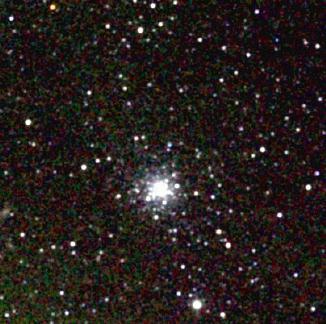 NGC 416 (Lindsay 83) is one of several populous star clusters in the Small
Magellanic Cloud (SMC), which are analogous to
globular clusters in our own Galaxy, but significantly younger. This cluster
was recently observed with the Hubble Space Telescope by Mighell, Sarajedini,
& French (1998, ApJ, 494, L189). From their deep photometric observations,
they derive an
age for the cluster of 6.6±0.5 Gyr. For comparison, the Galactic
globular cluster 47 Tuc is 13 Gyr old. NGC 416, however, is intermediate
in age, relative to other populous (or, globular) clusters in the SMC. The
metallicity, or heavy element content, is less for NGC 416 and the other
SMC clusters, relative to Galactic clusters, such as 47 Tuc, due to the
very different star formation history of the SMC, as compared to the Milky
Way.
The very red star seen in the SMC field, to the northeast of NGC 416 and
toward the edge of the image, is
likely to be a dust-obscured asymptotic giant-branch or carbon star in that
galaxy. (Field size 6.7´ × 6.7´. Image size 204 kB.)
NGC 416 (Lindsay 83) is one of several populous star clusters in the Small
Magellanic Cloud (SMC), which are analogous to
globular clusters in our own Galaxy, but significantly younger. This cluster
was recently observed with the Hubble Space Telescope by Mighell, Sarajedini,
& French (1998, ApJ, 494, L189). From their deep photometric observations,
they derive an
age for the cluster of 6.6±0.5 Gyr. For comparison, the Galactic
globular cluster 47 Tuc is 13 Gyr old. NGC 416, however, is intermediate
in age, relative to other populous (or, globular) clusters in the SMC. The
metallicity, or heavy element content, is less for NGC 416 and the other
SMC clusters, relative to Galactic clusters, such as 47 Tuc, due to the
very different star formation history of the SMC, as compared to the Milky
Way.
The very red star seen in the SMC field, to the northeast of NGC 416 and
toward the edge of the image, is
likely to be a dust-obscured asymptotic giant-branch or carbon star in that
galaxy. (Field size 6.7´ × 6.7´. Image size 204 kB.)
Return to 2MASS Atlas Image Gallery Homepage